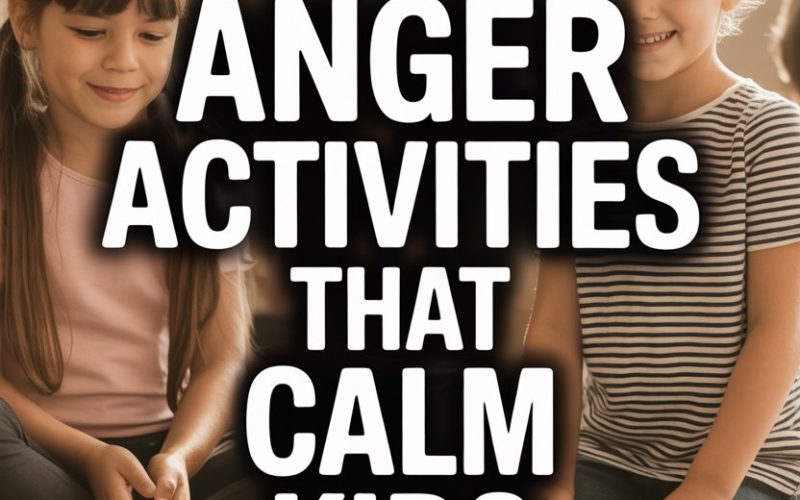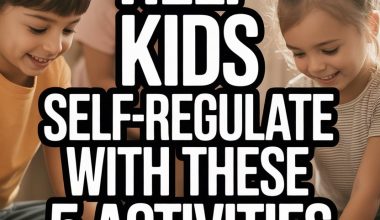Every parent knows the look: clenched fists, little jaw set, steam practically pouring out of those tiny ears. Childhood anger can turn even the sweetest cherub into a mini volcano.
And let’s be honest—kids aren’t exactly known for their nuanced self-regulation.
Fortunately, there are straightforward ways to help kids regain their cool fast, without needing a psychology degree or a secret meditation room.
Below, you’ll find ten go-to anger diffusers you can pull out anytime, whether your little one is fuming over a sibling’s “borrowed” toy or a bedtime conspiracy.
1. The Power of the Angry Scribble
Hand your child a piece of paper and some crayons (bonus points for glitter pens) and invite them to draw what their anger feels like.
Tell them to press hard, use wild colours, scribble big, small, fast, slow—whatever matches their mood.
Art therapists often recommend this approach for good reason. The physical motion offers a safe vent for all that pent-up energy, and the visual aspect helps kids externalize what’s swirling inside.
They can crumple, rip, or stomp on the finished masterpiece if it helps—creative destruction with zero clean-up (unless you used the glitter pens).
2. Bubble Breaths That Actually Work
Ask a five-year-old to “take a deep breath” and you’ll probably get a dramatic sigh (or an eye roll, if you’re raising a prodigy). But ask them to pretend to blow the world’s biggest bubble, and suddenly everyone’s in.
Have your child purse their lips, inhale slowly through their nose, then exhale gently as if blowing a giant bubble.
This kind of playful breathwork is shown to activate the parasympathetic nervous system—which is science-speak for “it calms their little bodies down.” Plus, it’s hard to stay furious when you’re pretending to be a bubble machine.
3. The Cold Water Reset
Sometimes, the quickest way to short-circuit rage is with a little sensory surprise. Invite your child to wash their hands (or face) with cool water, or give them a damp washcloth to press against their cheeks.
This technique comes straight from occupational therapists. The sensation of cold water delivers a gentle jolt to the system, interrupting runaway emotions and providing a fresh start.
Just watch out for the inevitable water fight if you have more than one kid.
4. Stomp It Out With a Movement Game
That angry energy has to go somewhere. Try inventing a silly “Stomp the Mad Out” dance together—think exaggerated stomps, wild arm swings, even grumpy faces on purpose.
Moving large muscle groups helps burn off adrenaline, which floods the body during anger. If you’re feeling brave, turn on a favourite song and let them go wild.
Bonus: movement games offer a little exercise for you, too.
5. The Squeeze-and-Release Trick
Muscle tension loves to tag along with angry feelings. Teach your child to squeeze their fists as tight as possible for five seconds, then let go and shake their hands out.
Repeat a couple of times, perhaps with their shoulders or feet.
Progressive muscle relaxation isn’t just for grown-ups. Even young children can learn to spot the difference between “tight” and “loose,” helping them recognize when their bodies are gearing up for a meltdown.
For many kids, this simple physical reset is more accessible than traditional calm-down techniques.
6. Story Time for the Soul
When tempers flare, sometimes distraction is the best medicine. Grab a favourite picture book—ideally one that’s funny, comforting, or even about big feelings.
Some classics like “The Colour Monster” or “When Sophie Gets Angry—Really, Really Angry” are written specifically for these moments.
Reading together isn’t just a distraction; research shows shared reading can lower stress hormones and create a sense of safety.
Plus, snuggling up for a story makes even the angriest tot feel a bit more connected to you (and less like unleashing their inner Godzilla).
7. The Magic of Name That Feeling
Annoyed? Furious? About to spontaneously combust? Little kids are often stuck at “mad,” but teaching them a broader emotional vocabulary can help them process what’s happening.
During a quiet moment (not mid-meltdown), play an emotions-guessing game: “Can you show me your best ‘frustrated’ face?” or “What does ‘disappointed’ look like?”
The aim isn’t to diagnose every feeling, but to give your child more emotional tools. According to child development experts, kids who can name their feelings are better at managing them.
8. The Calm-Down Corner—With a Twist
Forget the old “naughty step.” Create a cozy spot in your home with soft pillows, a favourite stuffed animal, maybe a sensory toy or two.
But don’t call it a time-out; this is a “calm-down corner” (or whatever creative name your child picks—“dragon’s den” works for some).
Invite your child to retreat there when big feelings strike, not as punishment but as self-care. Fill the space with things that soothe your child—think squishy stress balls, a lava lamp, or even headphones for quiet music.
Many parents swear by this gentle approach, and studies back up the idea: having a predictable, pleasant place to recalibrate reduces the intensity of outbursts.
9. Blow Up Balloons (Real or Imaginary)
The act of blowing up a balloon—slow inhale, long exhale—has anxiety-busting powers. Hand your child a real balloon, or pretend if you’re all out.
Exaggerate each breath: “Let’s fill it up as big as a watermelon!” Watch their body language shift as they focus on the task.
This activity isn’t just distracting; it slows the heart rate and helps regulate breathing.
For kids who love a little showmanship, encourage them to pop the balloon at the end with a loud “POW!”—sometimes a noisy finale is just what the doctor ordered.
10. DIY Sensory Bottles
You don’t need a craft degree or a hot glue gun.
Grab a clear plastic bottle, fill it with water, add a dash of glitter, a squirt of washing-up liquid, and perhaps a few buttons or sequins. Seal it tightly (superglue if you’re wise) and hand it over to your little one.
When anger rises, invite them to shake the bottle hard and then watch as the swirling contents settle. This visual focus acts like an anchor, gently pulling attention away from rage.
Sensory bottles offer a portable moment of peace—plus, they’re a hit at playdates and parties.
When You Need a Quick Win
Kids and anger go together like jam and toast—messy, sticky, and inevitable. No parent expects their child to be a Zen master at four, or eight, or even fifteen.
The trick is to give them practical tools and the confidence to use them, then stand back (sometimes behind actual furniture) and let the magic work.
Every child is different. You may need to kiss a few frogs (not literally, unless you have a very odd family tradition) before you find the anger-calming activity that works for yours.
Some days, nothing will work. That’s normal too.
But bit by bit, with a little creativity and plenty of patience, those angry storms get shorter, gentler, and easier to weather.
And who knows? Your child might even teach you a thing or two about keeping your own cool.





